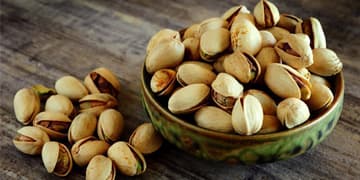
The history of pistachio in Iran
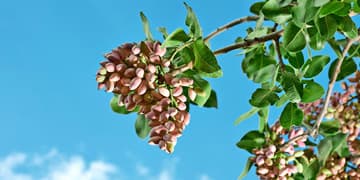
Pistachio tree in Iran
The height of this tree reaches about 309 cm and itscrown is averagely394 cm.
The pistachio tree blooms early, but its fruit does not bearsoon;
it usually bears late and needs a lot of care so that it does not suffer from pests.
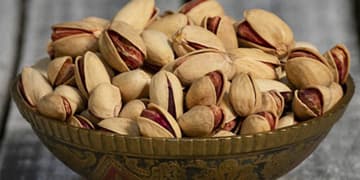
Types of Iran’s export pistachio
Iran’s pistachio commercial types are divided into two groups: round pistachio including hazelnut pistachio and jumbo pistachio, and long pistachio includingAkbari pistachio and Ahmad Aghaei pistachio.
More information
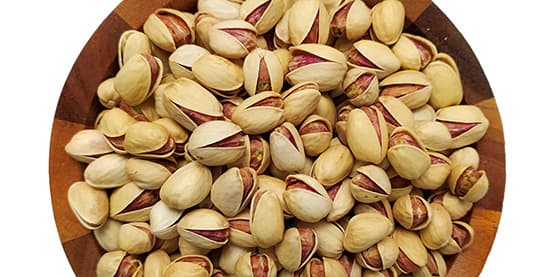
Hazelnut pistachio
Because of its small size, hazelnut pistachio is higher than other Iranian pistachios and includes more pistachios per kilogram.Hazelnut pistachiois usually found in sizes 28-30, 32-34 and 30-32.
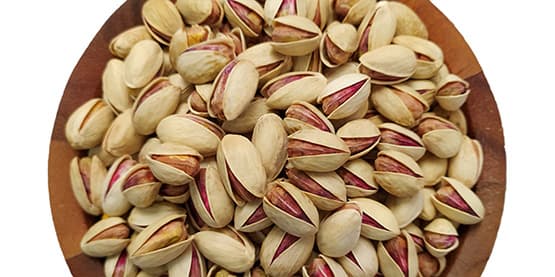
Ahmad Aghaei pistachio
Ahmad Aghaei pistachio is one of the largest and most delicious types of commercial pistachio in Iran, which is very popular in the markets of Iran and the world.
Regarding the taste, it is the most delicious type in Iran, and regarding the amount of production, it has the most abundant type of pistachio because of high quality in grafting and high yield in Iran.
Ahmad Aghaei pistachio is almond-shaped, more elongated and larger than hazelnut pistachio, and smaller than Akbari pistachio.
Its appearance is similar tojumbo pistachio. Ahmad Aghaei pistachio is available in sizes 22-24, 24-26, 26-28.
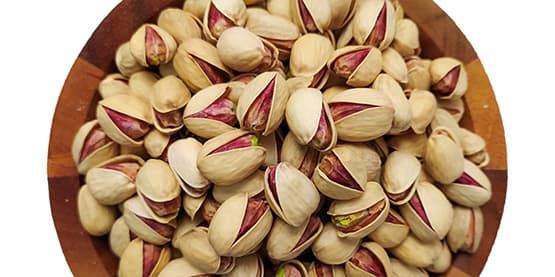
Jumbo pistachio
Jumbopistachio is one of the most delicious and largesttypes of commercial pistachio in Iran.This type of pistachio is round and spherical and is similar to hazelnut pistachio, but its size is larger and its weight is heavier than hazelnut pistachio.
The popularity of jumbo pistachio is because ofitslarge kernel and its very delicious taste.This type of pistachiois available in sizes 20-22/22-24/24-26.
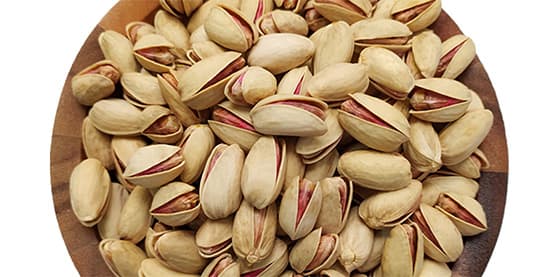
Akbari pistachio
Akbari pistachio is the most luxury, the best, and the highest quality type of export pistachiosin Iran. Akbari pistachio is more elongated than Ahmad Aghaei, hazelnut, and jumbo pistachios, has a higher commercial value, and is known as super long pistachio. The kernelof Akbari pistachio is larger and more elongatedthan other Iranian pistachios, and has a very good taste. Akbari pistachio is one of the commercial typesof pistachio with the highest economic value. Its fruits are almond-shaped, elongated, and large.Of its characteristics are high vegetative growth, dense leaves, wide leaf area, high yield, late flowering and late ripening.Itcould be harvested in the third decade of September. Akbari pistachio has a very strong and compressed wood, is almond-shaped, and is produced in sizes 20-22, 22-24, 24-26 in Iran’s pistachio-rich regions.
Commercial types | Hazelnut pistachio | Jumbo pistachio | Ahmad Aghaei pistachio | Akbari pistachio |
|---|---|---|---|---|
Shape | spherical shape and small | spherical shape and large | elongated and almond-shaped | elongated and almond-shaped |
Average size of each pistachio (mm2) | 1.40 | 1.50-1.70 | 1.50-1.60 | 1.80-1.90 |
Average weight of each pistachio | 0.97g | 1.71g | 1.32g | 1.45g |
Average weight of dry kernel ofeach pistachio | 0.44g | 1.45g | 0.75g | 0.66g |
Number of each pistachio in per kilogram | 1000-1100 | 700-800 | 800-900 | 800-900 |
And More ...

Iran’s pistachio harvest time
Iran’s commercial pistachio types are usually harvested in September. When 70-80% of the outer shellof pistachio fruits is easily removed from the hard shellof the bone, it is the harvest time.Also, the color change of the outer shellfrom green to pink to purple is another sign of pistachio’s ripening. However, its exact time varies from year to year, land and weather conditions, tree pollination status, soil salinity and irrigation directly affect the harvest time and the yield of Ahmad Aghaei pistachio trees.

Steps of harvesting and processing of Iran’s commercial pistachio types
The harvested pistachios should be transferred to processing terminals as soon as possible. In order to produce the final dry pistachio, first the product imported from the garden is entered the peeling machine, then the soft shell, cluster tail, leaves and other additional parts are separated and removed from the line.
Afterwards, the peeled pistachios are immersed and washed in clean water pools; the unripe and semi-kernel pistachios are separated from the fully ripe pistachios (unripe pistachios are placed on the water surface and ripe pistachios are placed under the water). The washed ripe pistachios are then controlled by manpower and the broken pistachios or those brokenby the machine during the peeling operation are separated.
Then, in the mechanized state, the cleaned pistachios enter the dryerand their excess water and some of the pistachio kernel moisture is removed. The pistachios are then placed into the dryeror spread on the groundto be dried by the heat of the sun. Pistachios should be left in the dryer for about 8 hours at a temperature of 50-60℃,and during heating, they should be stirred and ventilated so that the heat and air flow areblownto all parts of the product evenly.
The dried product is graded to become more uniform. Grading involves separating smiling pistachios from the non-smiling (closed mouth) ones as well as separating and classifying each pistachio according to itsounce (size), which is done by screensspecific for grading pistachio or by skilled manpower.
The prepared product is packaged in hemp bags or small containers in the forms of nylon, cellophane and cansto be marketed. The packaged product should be stored in a warehouse at a temperature of 5-10℃ and be kept in a low humidity condition with impermeable floors and walls.Ventilation is also necessary for air conditioning. It is necessary to place the pallet on the floor of the warehouse to prevent moisture transfer from the floor of the warehouse to the product and its possible contamination.

Pistachio calories
Properties and benefits of eating pistachio
1. Pistachiohas low calorie, low cholesterol, and low saturated fat. Fat is an energy source that helps absorb vitamins K, A, E, and D.
2. Pistachio contains a lot of fiber, which helps digest food and regulate cholesterol and blood glucose.
3. Pistachio is one of the best sources of potassium, which has the same amount of potassium as orange. The potassium of pistachio helps balance body fluids, regulate heart rate and lower blood pressure.
4. Pistachio has phosphorus. Phosphorus is very useful for reinforcing bone and tooth tissue and strengthening the body muscles.
5. One of the reasons people develop anemia is iron deficiency. Pistachio, which contains iron, is a very useful fruit to compensate for iron deficiency and relieve dizziness and fatigue caused by anemia.
6. Eating pistachio increases sexuality.
7. Balanced consumption of pistachio strengthens hair and prevents hair loss, because it is a very good source of biotin. Biotin is a kind ofvitaminB that plays a critical role in hair strength and health.
8. Pistachioisfull of copper, magnesium, and different kinds of vitamin B that strengthen the immune system and prevent many diseases. Vitamin B6 is essential for maintaining immunesystem function. The deficiency of vitamin B6 leads to immune system dysfunction to fight infections.
9. The proverb “Still waters run deep” may beappropriate for pistachio. Although pistachiois small in size, it is very rich in minerals and vitamins.

The disadvantages of pistachio

Pistachio allergy

Pistachio’s maintenance method

How to distinguish high-quality pistachios from old pistachios?

How to use pistachio and its products?
• Raw or roasted pistachios,mixed with condiments such as salt and saffron, are always among the favorite snacks of most people.
• Pistachio kernels and pistachio slices: Pistachio kernels and slices are known as main products in most confectionery, chocolate, ice cream, and sausage industries due to their interesting taste and smell, high durability, marketability, and high productivity. They are used in many homemade products like traditional sweets such as Turkish baklava, cakes, desserts, and delicious and energetic juices.
• Pistachio oil: Pistachio oil is in golden-yellow or greenish-yellow color and contains 20% of different fatty acids. Pistachio oil is obtained from pistachio kernel extract as clear and yellow oil, and is widely used in the cosmetic and traditional medicine industries. Pistachio oil is a desirable moisturizer, is quickly absorbed, does not cause adhesion, and is appropriate for massaging the face and body.
• Pistachio paste: Pistachio paste is a product processed from Iranian high-quality pistachio kernels with 99% purity and without any additives. Pistachio’sdifferent tastes and special capabilities have led to varioususages in different industries including confectionery, cooking, chocolate, and dairy.
• Pistachio butter: Due to the nutritional value and benefits of pistachio, many people eat pistachio butter as an amazing and appetizing breakfast or snack. Pistachio butter, like pistachio paste, is a processed product of pistachio kernels that is used as breakfast or dinner with a variety of fruits.
